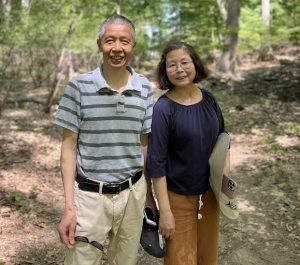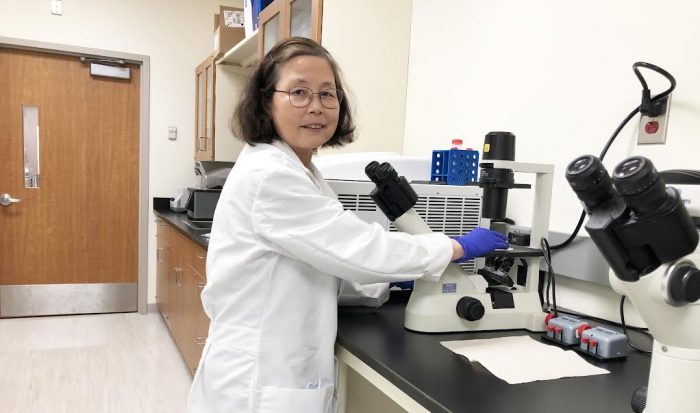SBU adds husband-wife team to cancer, pathology research – Part 1
By Daniel Dunaief
This is part one of a two-part series.
As Erin Brockovich (the real life version and the one played by Julia Roberts in the eponymous movie) discovered, some metals, such as hexavalent chromium can cause cancer in humans.

Environmental exposure to a range of chemicals, such as hexavalent chromium, benzo(a)pyrene, arsenic, and others, individually and in combination, can lead to health problems, including cancer.
Recently, Stony Brook University hired Chengfeng Yang and Zhishan Wang, a husband and wife team to join the Cancer Center and the Pathology Departments from Case Western Reserve University in Ohio.
The duo, who have their own labs and share equipment, resources and sometimes researchers, are seeking to understand the epigenetic effect exposure to chemicals has on the body. Yang focuses primarily on hexavalent chromium, while Wang works on the mechanism of mixed exposures.
In part one, TBR News Media highlights the work of Wang. Next week, we will feature the efforts of Yang.
——————————-
In certain areas and specific job sites, people can be exposed to environmental pollutants.
Sometimes, the introduction of a metal or element can cause cancer after long term exposure. The effect of another carcinogen can be synergistic in triggering disease, triggering a stronger progression of cancer than an individual exposure alone.
Zhishan Wang, who joined Stony Brook in March and is a Professor of Research in the Department of Pathology, is trying to understand what changes this mixed exposure creates at a molecular level.
“If we find out some gene or pathway change, we can try to intervene,” said Wang, who is a member of the Stony Brook Cancer Center and earned MD and PhD degrees from her native China.
Among the many possible environmental triggers, Wang chose to study arsenic, which is common in rock soil and water and is present in some places in drinking water.
“People living in high exposure areas to arsenic and [who] are also cigarette smokers have a significantly higher risk of lung cancer,” she said.
Arsenic can cause three different kinds of cancer: skin, bladder and lung cancer. For skin cancer, Wang explained that direct contact can lead to the kind of irritation that promotes the disease.
As the heavy metal works its way through the body, parts of it get excreted through the urine system, which means that bladder cells come into contact with it as well.
For a long time, scientists knew arsenic exposure through drinking water caused lung cancer. The underlying mechanism for the development of that cancer was not well understood.
Wang’s lab studies the mechanism by which arsenic and benzo(a)pyrene (or BAP) co-exposure increases lung cancer risk. Exposure to arsenic alone causes cancer, but it takes a long time in animal models. Arsenic and BPA co-exposure significantly increases lung cancer risk.
Wang’s study showed that co-exposure increases lung tumor burden and malignancy. She plans to continue to study the mechanism of how arsenic and BAP co exposure increases lung cancer risk.
“That’s our big goal: to try to find some useful method to prevent this tumor from happening,” she said.
Wang believes the cancer cells caused by the mixed exposure increases the number of cancer stem cell-like cells, which could mediate therapeutic resistance.
Wang explained that generating the mouse model took considerable time and effort. She tried to find the exposures during particular windows of time that lead to cancer.
“By using this model, we can do a lot of data analysis” including single cell analysis and can determine which cluster or pathway will change.
Choosing SBU
Wang suggested she and her husband chose Stony Brook for several reasons. The couple would like to help the University earn a National Cancer Institute (NCI) designation, which would give scientists the ability to compete for ambitious, well-funded, multidisciplinary efforts.
Both Wang and Yang “lead NCI-funded research programs that will enhance the [Cancer Center’s] eligibility for NCI designation,” explained Kenneth Shroyer, chair of the Pathology Department at Stony Brook.
Shroyer, who described both researchers as “highly competitive candidates with the potential to enhance the status of any cancer center,” is looking forward to working with his newest recruits.
Wang is eager to use the tissue bank at Stony Brook, which Shroyer explained has also attracted other cancer research scientists recruited to the Renaissance School of Medicine at Stony Brook.
The new scientists also hope to tap into the expertise at nearby Cold Spring Harbor Laboratory, which has become one of the leading centers in creating organoids.
In the early years of her training during her MD and PhD years in China, Wang developed her technical skills. Through her career, she has worked on several genes that play important roles in carcinogenesis. Down regulation of the gene known as SOCS3, for suppressor of cytokine signaling 3, plays an important role in arsenic and BAP co-exposure caused lung tumorigenesis.
Early in their careers, Wang worked in her husband’s lab for seven years until she received her own research funding.
Outside of work, Wang enjoys playing badminton and ping pong. She also cooks every day. She and her husband bring her home cooked meals to work.
When she was in high school, Wang had ambitions to become a writer. Her teachers regularly read her work out loud to the class.
Her father, who was a lawyer, had encouraged her to join the legal profession. She had heard that people called others “smart” when they joined the fields of Science, Technology, Engineering and Mathematics. “I want people to call me smart,” she said, so she changed her career and went to medical school at Tongji Medical University where she earned top scores.
Her father had a stroke, surviving afterwards for seven years. When she was in medical school, Wang hoped to learn ways to help him. Wishing she could have done more, she pursued clinical research in the lab. She passed the tests to become a practicing physician in the United States, but she was more inspired to work as a scientist.
As for her work at Stony Brook University, Wang appreciates the beauty of Long Island. She hopes this is their “last move,” as they continue their careers.







